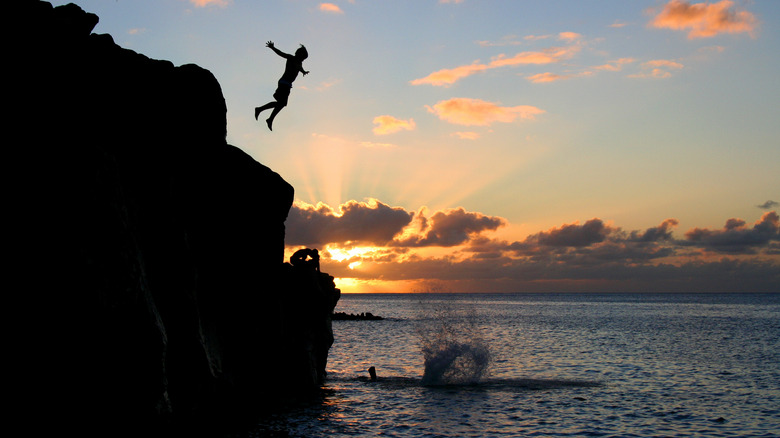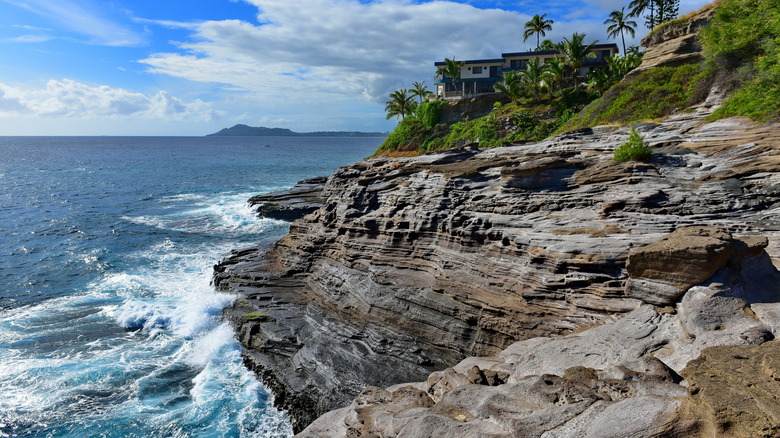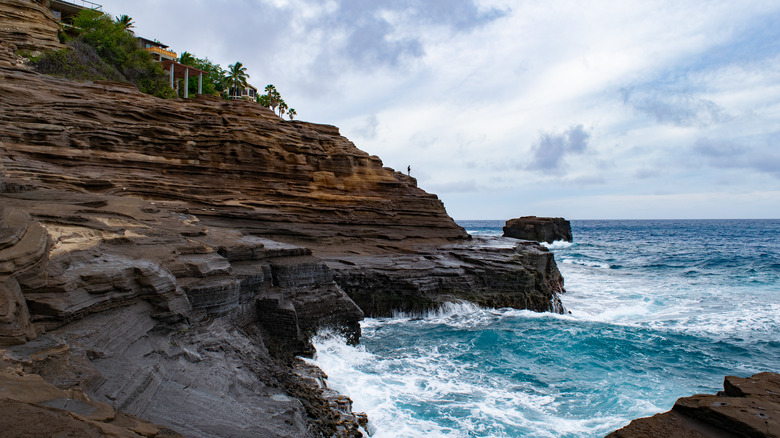Visit One Of The World's Best Cliff-Jumping Spots At This Hawaiian Island
Cliff diving is one of the oldest extreme sports in the world. It holds special significance in Hawaiian culture, in particular, as it was brought into vogue by King Kahekili of Maui in the 18th century. He was known to jump into the sea from soaring heights as a display of bravery to his troops, urging his army to follow suit. He coined the sport lele kawa, which means leaping feet-first from a cliff into the water with minimal splashing. For over 200 years, locals have been jumping off of Oahu's stunning rock faces into the Pacific Ocean, inspiring travelers from all over to do the same. The Spitting Cave about 20 minutes outside of Honolulu is one such place, though it's best reserved for experienced divers only.
Sitting 70 feet above the ocean, Spitting Cave gets its name from a peculiar geological formation. At the bottom of the cliff, where the rock meets the sea, there's a cave that sucks in the water from the swell. When the water hits the back wall, it shoots back out of the cave horizontally, creating the appearance that the cave is spitting out the ocean. It's beautiful — and also very dangerous. But for some cliff divers in search of a thrill on Oahu, that's the whole point.
What to know about Spitting Cave
Spitting Cave is a stunning place to watch expert divers do their thing. It's not as easy as they make it look, of course, as the jump is only the first hurdle. Divers must time it perfectly with the wave so that they don't get smashed against the rocks or sucked inside the cave with the current. Assuming they clear the jump with finesse, divers then have to climb out of the water in the rough surf with a mix of sheer willpower and the aid of a ladder installed on the rocks. This is the part where many adrenaline junkies have required water rescue or, sadly, drowned. There are memorials at the top for a reason.
While the Honolulu Fire Department would prefer that folks stay away to avoid head injuries and broken bones, they know it's a popular spot for cliff divers. That said, if you're thinking about giving it a go, it's imperative to talk to experienced locals about proper timing, where to land, and how to exit the water safely. Do not attempt to do this on your own. In fact, it's best to have a spotter climb lower on the rocks to help you with timing. After all, even experienced swimmers have lost their lives here, so your swimming skills must be top-notch. And, of course, do not cliff dive under the influence, as that's exactly how two swimmers got stranded in the surf and required a water rescue.
Tips for visiting and more dive options
Beyond cliff jumping, Spitting Cave is a prime spot to catch a sunset and whale watch. From November to April, humpback whales migrate from Alaska to Hawaii to breed and give birth to their young. If you're lucky, you might spot a few. The lookout is in the middle of a residential neighborhood, so plug it into Google Maps and park on Lumahai Street. Just be respectful, and don't block someone's driveway. Between two houses, there's a back alley that leads to a trail. After it rains, it's steep and gets muddy, so wear hiking shoes. Once you get to the cliffs, head right for an epic view of the cave spitting water from the side.
If the cliff divers at Spitting Cave tempt you, but you're not quite ready for that 70-footer, head around the corner to China Walls. The geography is similar, and the view is gorgeous, but the cliffs are only 5 to 20 feet high. The rocks are angled at varying heights, so you can take your pick (for scale, a diving board above a pool is about 3 feet high). On the other side of the island, Waimea Bay's 30-foot jump and Laie Point's 30-foot jump are other popular spots, the latter being the filming location for the jump scene in the 2008 comedy "Forgetting Sarah Marshall." Whether you participate in this Hawaiian tradition or watch for a hit of adrenaline, stay safe out there.


